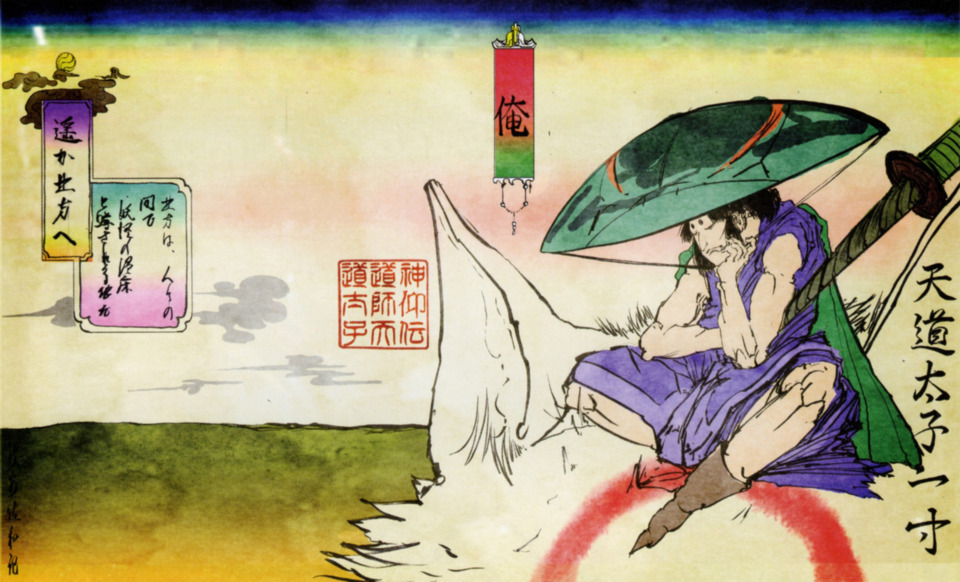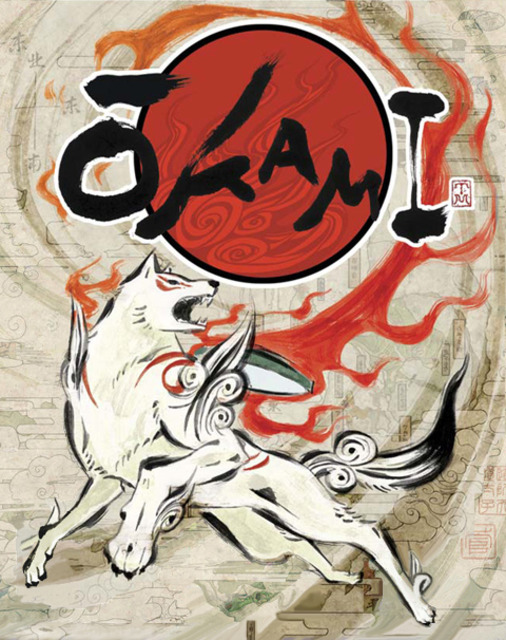A Simple and Richly Artistic Adventure

There are few games that devote themselves so much to the concept of historical art as much Okami does. I would say the majority of the player experience does not involve the registration of what is being played, but rather what is being seen and heard, which is vastly distinct compared to other games. Perhaps this notion is contrary to the very rational fabric of what it means to be a video game, but Okami succeeds in its artistic qualities, which impress largely due to its veneration toward older Japanese movements in religion, painting, folklore, music, and societal idioms. By comparison, the gameplay is simple; but perhaps it was the intention by the designers to keep the nature of the game rather conservative to embellish its sublime artistic arrangements.
The gameplay of Okami is designed as an Adventure game, very similar to the Legend of Zelda games from 1998-2006. This analogy greatly demonstrates the tasks one will undertake and the method it will be done; following in the footsteps of the Legend of Zelda is a safe and tried tactic, but Okami provides inventiveness of its own as well. A defining component to this game is the creative implementation of the “celestial brush,” allowing us to use a passel of elemental affinities to solve traditional dungeon puzzles as well as the miniature puzzles that inhere in combat. The celestial brush is not without flaws, however I still think in many ways it is a tremendous benefit to the identity of the game despite its issues.
Activating the celestial brush is still quite striking, and its revelation is a moment that I talk to many people rather fondly about; triggering this pauses the movement of the world, as it blanches to a monochromatic outline of the world, where the brush is the only element that can elect to interact with the game. The musical arrangement of this moment is a manifold instrumentation layered by shamisens, chimes, and woodwind instruments that heighten the surreal dreaminess and, due to repetition, becomes the motif of the game. As I hear the theme of the celestial brush, inside me stirs the emotions I felt when I first played it, demonstrating to me that it was an ineffaceable sound. The composition of the soundtrack is equally as exotic as its visual style and as proudly Japanese. When not spent in the verdant field of the countryside, the game offers authentic portrayals of the cultural design as seen in classic Japanese printmaking. These specific characteristics carry into the combat arenas, which introduce demons that are simplified and bowdlerized from the grotesqueness of traditional Japanese rendition, however still animate wonderfully alive yet perversely appalling.
Combat and puzzles are easy to interpret despite the matrix of possible combination brush techniques bestowed upon you. Thankfully these are not made complex – entering the brushstrokes to activate elemental affinities are not as analog as it would be to press a button, and I would argue even it is impossible to complete the game without having failed a few attempts at brushstroke techniques. To make up for this input tolerance, the AI seems to be unfortunately simplified and rather disengaging at times. However, there is great variety in the behavior of enemies that prevent the creeping feeling of monotony, but still remain as tests that do not offer much challenge. This will not do favors for some adults looking for a difficulty proportional to what they might expect , but I think someone at an early teenage level will truly revel participating along the journey and might not find the obstacles as facile. It is a mostly friendly adventure, and does occasionally service more engaging encounters during bigger moments.
The story of the journey is a warm paean to the mythology and folklore set by the Shintoists of ancient Japan. The obstacles and tasks are myopically set by the game, making the game fractured into episodes connected by a visible form eventually into an epic worthy of its influences. I felt so much excitement ending an episode, wondering if I had indeed accomplished my journey-long objective, to only be told that I was far from finished. It is a rather simple trick for them to pull, but I was duped several times during the game, as the adventure wound up to be twice as long as I had originally sussed Okami to be. I think many people are left impressed by these surprises, but the scarcity of depth in combat does not gain from these switches. Although the mechanics begin to hold less importance, the progression of the narrative begins to lends powerful feelings only long and perilous journeys can render. It is a disappointment that much of the story must be conveyed through the proxy of Issun. He is a likeable enough fellow, but is rather talky and has a noisome tendency to attempt snowing buxom female figures for what seems like a fair majority of his speech; Issun is not interesting enough to rightfully compliment the poetry of Okami’s tale of nature, prophecy, and spirituality. In fact, many of the pivotal characters we meet are can be quite dull compared to the flavor of the minor characters and the story. These shortcomings are not enough to overshadow the success of the game's blessings and inventions, but it prevents it from becoming an all-time favorite of mine.
Although I have said much toward the praises of Okami's artistic values, perhaps there really is not much of a need for it. All one simply has to do is compare many of the game’s usage of detailed graphic art to those of classical ukiyo-e or witness the rejuvenation of a blossom tree vivify an entire pastoral field. The visual style is so brave and compelling, that we must praise that this medium can provide something so rich and inspired. The developers at Clover Studio are clearly effusive about the culture of 19th century Japanese art, it is that passion that affected me and so many others, taking our predisposed affinities for immense detail in animation and making them legitimate and lovely by the device of their game. I've had numerous people tell me that this was their favorite game -- I certainly do not hold that against them.
